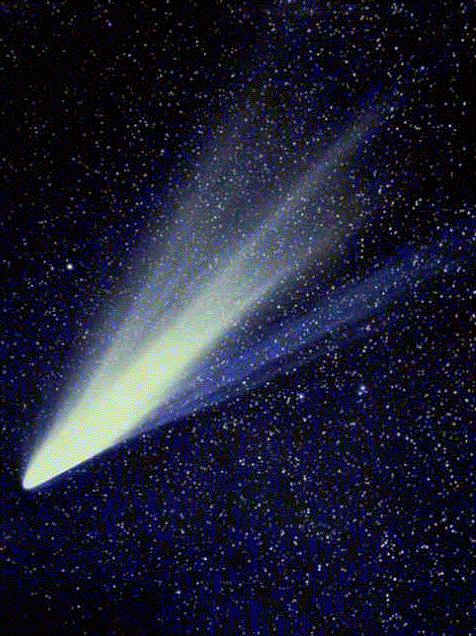The ion tail is thin, blue and linear - points directly away from the Sun.
The dust tail is white, broad and points generally (but not precisely) away from the Sun
What is happening?

| Comet tails come in two flavors: the ion
tail and the dust tail.
The ion tail is thin, blue and linear - points directly away from the Sun. The dust tail is white, broad and points generally (but not precisely) away from the Sun What is happening?
|
 |
Physics of the Ion Tail
The ion tail is made up of ions (surprise!) - mostly CO+, N2+, CO2+. As the comet comes into the inner solar system, the Sun's radiation heats up the nucleus, "boiling off" and ionizing these gases.These ions are electrically charged particles, and interact with the sun's solar wind (charged particles coming from the sun). The interaction between the comet and the solar wind distorts magnetic field lines, causing a cometary magnetotail which points away from the Sun. The charged ions stream along the magnetic field lines in the magnetotail, so the ion tail always points away from the Sun.
CO+ absorbs sunlight and flouresces, emitting energy at a wavelength of 4200 Angstroms, which is blue light.
Physics of the Dust Tail
The dust is not necessarily charged -- why should the dust tail point away from the Sun?I. Radiation Pressure
II. Solar wind collisions
- Remember that photons (particles of light) carry momentum, and can "push" on small dust grains.
- Balancing this pressure with gravity, we can solve for the size of grains affected: r<~0.006 cm -- small! Grains smaller than this will be pushed away from the Sun. Grains larger than this will be left behind along the comet tail (what will they become?).
- Actually, grains MUCH smaller than that won't absorb solar radiation as efficiently, so something else must be pushing on them -- collisions with solar wind particles.
Both radiation pressure and solar wind collisions are less effective at pushing on dust particles than magnetic fields are at containing ions, so the dust tail is broader than the ion tail, and it is not as precisely aligned away from the Sun as the ion tail is.Finally, the dust tail reflects sunlight, so it appears yellow/whitish in color.